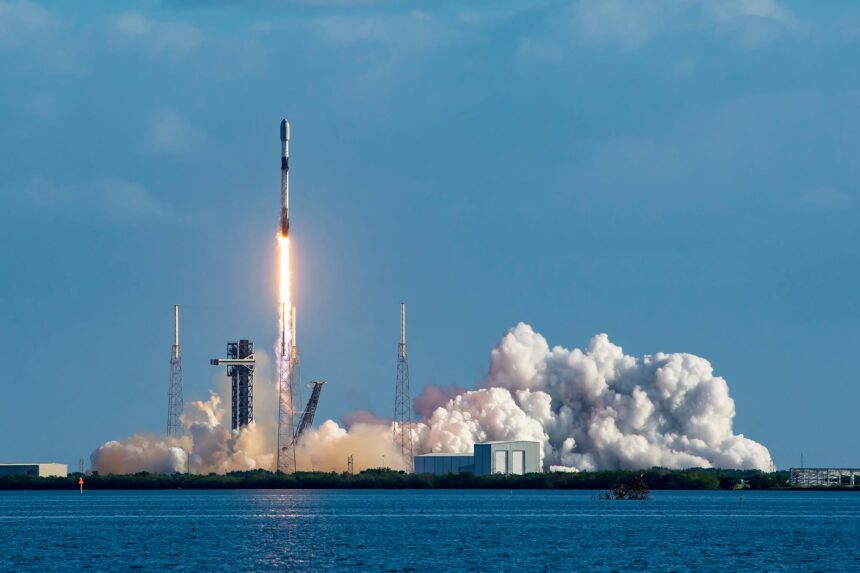SpaceX, led by Elon Musk, continues to dominate the aerospace industry with a series of successful launches in early 2025. With its ambitious Starlink satellite deployments, Starship test flights, and upcoming Mars missions, the company is pushing the boundaries of space exploration.
On February 10, 2025, SpaceX successfully launched a Falcon 9 rocket carrying 23 Starlink satellites from Vandenberg Space Force Base, California. The company also announced an upcoming Starlink launch from Cape Canaveral on February 11, 2025, along with several planned Starship test flights aimed at perfecting their interplanetary transport system.
This article breaks down all the latest updates, including key launches, test flight successes and failures, and Elon Musk’s bold plans for Mars exploration.
1. SpaceX Successfully Launches Starlink Satellites from Vandenberg
On February 10, 2025, SpaceX launched a Falcon 9 rocket carrying 23 Starlink satellites into low Earth orbit (LEO).
✔ Launch Site: Vandenberg Space Force Base, California
✔ Time: 6:09 PM PST
✔ Mission Goal: Expand Starlink’s internet coverage worldwide
The Starlink constellation is SpaceX’s ambitious project to provide global high-speed internet coverage, especially to rural and underserved areas. This latest launch brings the total number of Starlink satellites in orbit to over 5,500.
Why This Launch Matters?
✔ More satellites mean better internet coverage, reducing latency and improving connectivity in remote regions.
✔ SpaceX is moving toward launching next-gen Starlink satellites with laser links for faster data transmission.
✔ The mission proves Falcon 9’s reusability, as the first stage booster successfully landed on a droneship.
Observers in Bakersfield, California, and Southern Utah reported seeing the spectacular rocket trail, making it one of the most visually stunning launches of the year.
2. Upcoming SpaceX Starlink Launch from Cape Canaveral
Following the successful Vandenberg launch, SpaceX is preparing for another Starlink mission on February 11, 2025.
✔ Launch Site: Cape Canaveral Space Force Station, Florida
✔ Rocket: Falcon 9
✔ Payload: Additional Starlink satellites
This launch will further strengthen Starlink’s internet coverage across North America and Europe. SpaceX’s rapid deployment strategy shows how the company is inching closer to its goal of making Starlink the world’s most reliable satellite internet service.
3. Starship’s Seventh Test Flight Ends in Failure – But Data Was Gathered
One of SpaceX’s most highly anticipated events in early 2025 was the seventh test flight of the Starship rocket on January 16, 2025.
✔ Launch Site: Starbase, Texas
✔ Rocket: Starship SN27
✔ Mission Goal: Test booster recovery with mechanical “chopsticks” arms
✔ Outcome: Partial success – Booster landed, but Starship lost in space
This test flight marked an important milestone as SpaceX successfully demonstrated catching the Super Heavy booster using the launch tower’s “chopsticks” arms. However, the Starship second stage suffered engine failure, causing the vehicle to be lost 8.5 minutes into the mission.
Why This Test Was Still a Success?
✔ Valuable data was collected, which will help improve Starship’s reliability for future missions.
✔ Super Heavy’s booster recovery was a major breakthrough, proving that catching a falling booster with launch tower arms is possible.
✔ SpaceX is refining engine performance and software, making future Starship missions more reliable.
Elon Musk tweeted:
“Starship test was a partial success. Booster recovery was perfect, but we lost the second stage. Next launch in 6 weeks with major improvements.”
4. SpaceX Plans 5 Uncrewed Starship Flights to Mars by 2027
Elon Musk has big plans for Mars, and SpaceX is wasting no time. Musk recently confirmed that the company plans to launch at least five uncrewed Starship missions to Mars within the next two years.
✔ First mission targeted for the next Earth-Mars transfer window (late 2026).
✔ Goal: Land Starships on Mars to test refueling, life support, and cargo transport.
✔ If successful, crewed missions could follow by 2029.
How SpaceX Plans to Colonize Mars?
✔ Starship will serve as a reusable transport vehicle, ferrying humans and cargo between Earth and Mars.
✔ Mars refueling stations will use locally sourced methane to refuel Starships for return trips.
✔ SpaceX is developing sustainable habitats, oxygen generation systems, and radiation shielding for future Martian settlers.
Musk remains confident that the first humans will land on Mars within this decade. However, many technical and financial hurdles remain.
5. The Future of SpaceX’s Missions – What’s Next?
With back-to-back successful Starlink launches, Starship test flights, and an aggressive Mars colonization plan, SpaceX is making major progress.
What to Watch for Next?
✔ Starship’s Next Test Flight: Expected in March 2025 with upgraded engines.
✔ More Starlink Launches: SpaceX is set to launch two more Starlink missions in February.
✔ Lunar Missions: SpaceX will conduct test flights for NASA’s Artemis program, which plans to return humans to the Moon.
With each mission, SpaceX is proving that commercial space exploration is the future.
Final Thoughts: SpaceX is Paving the Way for the Future of Space Travel
SpaceX is making rapid advancements in space technology, from deploying Starlink satellites to testing Starship for Mars missions.
✔ Starlink continues to expand, bringing faster satellite internet to millions worldwide.
✔ Starship tests are proving that Mars colonization is getting closer to reality.
✔ Elon Musk’s vision of an interplanetary civilization is slowly but surely taking shape.
With more launches on the horizon, the question is: How soon will we see Starship successfully carry astronauts to Mars?
🚀 What do you think about SpaceX’s latest missions? Are we on track for a Mars colony in the next decade? Let us know in the comments below!






